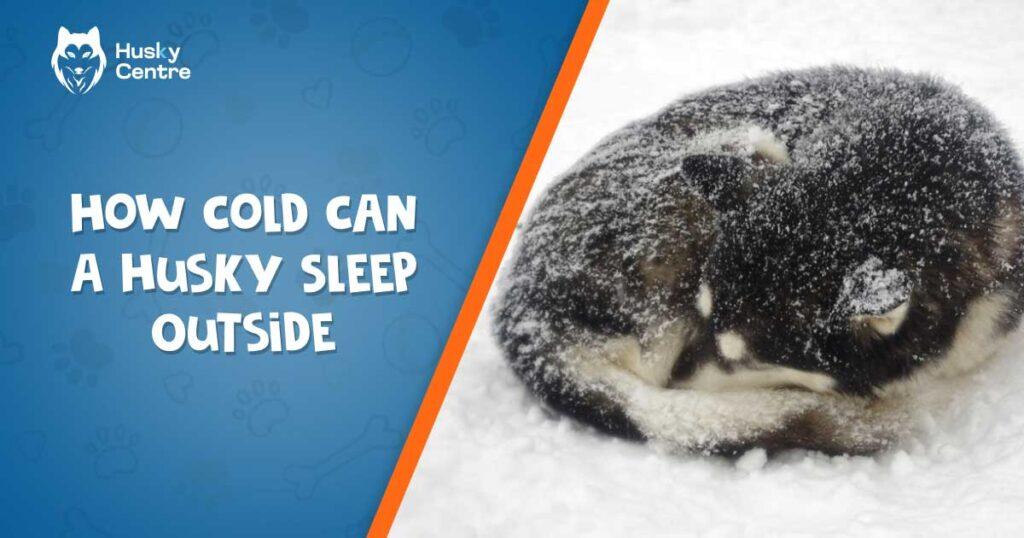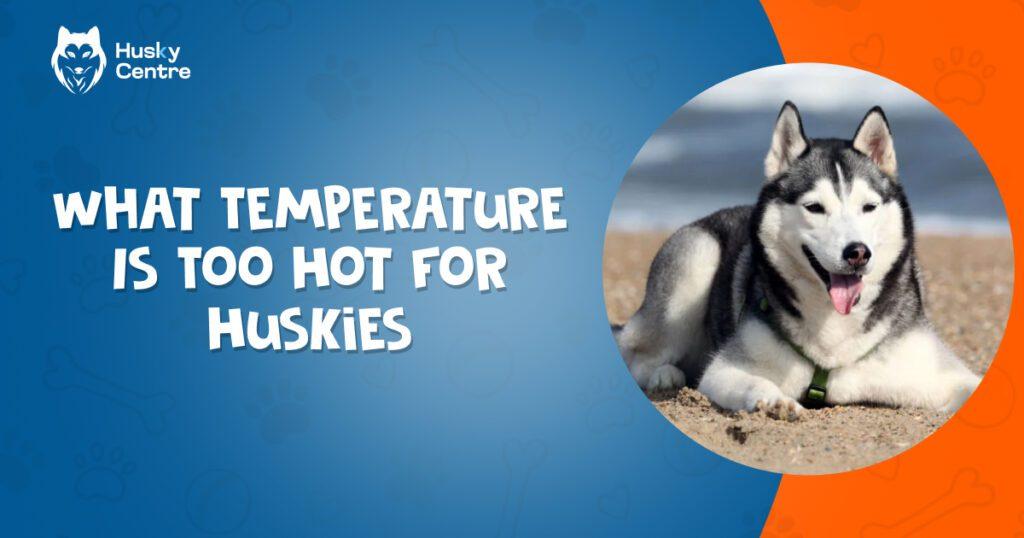Huskies can sleep outside in temperatures as low as -60°F. Their thick double coat provides excellent insulation.
Huskies are renowned for their resilience and adaptability to cold climates. Originating from Siberia, these dogs have evolved to thrive in extreme weather conditions. Their thick double coat, comprising a dense undercoat and a longer topcoat, offers remarkable insulation against freezing temperatures.
This natural protection allows them to sleep comfortably outdoors in conditions that would be intolerable for many other breeds. While their tolerance for cold is impressive, it’s essential to ensure they have adequate shelter and are not exposed to wet or windy conditions for extended periods. Proper care and attention are crucial to maintaining their health and well-being in harsh environments.
Understanding The Husky’s Cold Tolerance
How cold can a Husky sleep outside? Huskies are known for their incredible cold tolerance. Understanding the Husky’s cold tolerance is essential for ensuring their well-being during winter. Let’s explore the factors contributing to their ability to withstand freezing temperatures.
Origin And Natural Habitat
Siberian Huskies come from the harsh, cold climates of Siberia. These resilient dogs were bred by the Chukchi people of northeastern Asia.
Key aspects of their origin and habitat include:
- Extremely cold temperatures: Siberian winters can be brutally cold, often dropping below -50°F (-45°C).
- Snow-covered landscapes: The Chukchi people relied on Huskies for sledding across vast, snowy terrains.
- Survival in harsh conditions: Huskies were essential for transportation and survival in unforgiving environments.
Their history has ingrained a high tolerance for cold weather. This makes them well-suited for outdoor living even in freezing temperatures.
Physical Adaptations To Cold Weather
Huskies possess unique physical traits that help them thrive in cold climates. These adaptations are vital for their survival and comfort.
Some of these physical adaptations include:
| Adaptation | Description |
| Double-layered coat | Huskies have a dense undercoat and a longer outer coat, providing excellent insulation. |
| Thick fur on paws | Their paws are well-insulated with fur, protecting them from cold and ice. |
| Compact body structure | Huskies have a muscular build that helps conserve body heat. |
| Erect ears | Their ears stand upright, reducing the risk of frostbite. |
These adaptations ensure Huskies remain warm and comfortable, even in extreme cold.
Typical Behavior In Cold Climates
Huskies exhibit specific behaviors that help them cope with cold weather. These behaviors are crucial for their survival and comfort.
Common behaviors include:
- Burrowing: Huskies often dig into the snow to create insulated sleeping areas.
- Curled-up sleeping position: They curl up to minimize heat loss and protect vital organs.
- Increased activity: Huskies stay active to generate body heat, even in freezing temperatures.
- Thickening coat: Their fur becomes denser in winter to provide extra insulation.
These behaviors highlight the Husky’s ability to adapt and thrive in cold environments. Their natural instincts and physical traits make them well-equipped for outdoor living in winter.
Factors Affecting A Husky’s Ability To Sleep Outside
Huskies are known for their ability to endure cold weather. But how cold can a Husky sleep outside? Various factors affect a Husky’s ability to sleep comfortably in cold temperatures. Let’s explore these factors to ensure your Husky stays warm and safe outdoors.
Age And Health
The age and health of a Husky play a crucial role in determining its cold tolerance. Puppies and senior dogs are more vulnerable to cold temperatures.
- Puppies have less body fat and a thinner coat.
- Senior Huskies may have health issues that make them susceptible to cold.
It’s essential to monitor their health and provide extra warmth. Common health issues that affect cold tolerance include:
| Health Issue | Impact on Cold Tolerance |
| Arthritis | Reduces mobility, making it harder to stay warm |
| Heart conditions | Less efficient blood circulation |
| Respiratory problems | Difficulty in regulating body temperature |
Regular vet check-ups can help ensure your Husky’s health is optimal for cold weather.
Coat Condition And Thickness
A Husky’s coat condition and thickness are vital in determining its ability to sleep outside in cold weather. A healthy coat provides better insulation.
Factors affecting coat condition include:
- Nutrition
- Grooming
- Health
Ensure your Husky’s coat is thick and healthy by:
- Providing a balanced diet rich in omega-3 fatty acids.
- Regular grooming to remove dead fur and stimulate new growth.
- Checking for skin conditions or parasites.
A thick, well-maintained coat can significantly enhance your Husky’s cold tolerance.
Acclimation To Cold Weather
Acclimation to cold weather is another crucial factor. Huskies that are gradually exposed to cold temperatures adapt better.
To acclimate your Husky:
- Start with short periods outside in colder weather.
- Gradually increase the time spent outdoors.
- Monitor your Husky for signs of discomfort or cold stress.
Signs of poor acclimation include:
- Shivering
- Whining
- Seeking shelter
Proper acclimation helps your Husky build tolerance and stay comfortable in colder temperatures.
Activity Level And Nutrition
A Husky’s activity level and nutrition greatly influence its ability to sleep outside in the cold. Active Huskies generate more body heat.
Ensure your Husky stays active by:
- Providing regular exercise
- Engaging in outdoor activities
- Playing games that stimulate movement
Nutrition is equally important. A diet rich in proteins and healthy fats helps maintain body heat.
| Nutrient | Benefit |
| Protein | Builds muscle and supports overall health |
| Healthy fats | Provides energy and helps maintain body warmth |
By ensuring your Husky remains active and well-nourished, you can improve its cold tolerance and overall well-being.
Assessing Safe Temperature Ranges
Huskies are known for their ability to withstand cold temperatures. But, how cold can a Husky sleep outside? Assessing safe temperature ranges is crucial to ensure your furry friend stays comfortable and healthy. Understanding the general guidelines for cold weather tolerance, recognizing signs of hypothermia and frostbite, and considering individual variations are key factors.
General Guidelines For Cold Weather Tolerance
Huskies have a thick double coat that provides excellent insulation. This makes them more tolerant of cold weather compared to other breeds. Here are some general guidelines:
- Above 32°F (0°C): Safe and comfortable for most Huskies.
- 20°F to 32°F (-6°C to 0°C): Still safe, but monitor for signs of discomfort.
- 10°F to 20°F (-12°C to -6°C): Use caution; provide shelter and warm bedding.
- Below 10°F (-12°C): High risk of hypothermia and frostbite. Limit outdoor exposure.
Always ensure your Husky has access to a warm, dry shelter. Even with their natural insulation, prolonged exposure to extreme cold can be harmful. A heated dog house or an insulated kennel can provide extra protection.
Signs Of Hypothermia And Frostbite
Recognizing the signs of hypothermia and frostbite is crucial. Early detection can prevent serious health issues. Here are some symptoms to watch for:
| Condition | Signs |
| Hypothermia | ShiveringWeaknessSlowed breathingClumsiness |
| Frostbite | Pale, cold skinSwellingBlistersBlackened skin |
If you observe any of these signs, bring your Husky indoors immediately. Warm them gradually with blankets and warm (not hot) water. Seek veterinary attention if symptoms persist.
Variations Based On Individual Dogs
Not all Huskies are the same. Individual tolerance to cold can vary based on several factors. Here are some considerations:
- Age: Puppies and older dogs are more sensitive to cold.
- Health: Dogs with health issues may have lower cold tolerance.
- Acclimatization: Huskies raised in warmer climates may struggle more in cold weather.
Monitor your Husky’s behavior and adjust their outdoor time accordingly. Some Huskies may enjoy playing in the snow, while others may prefer shorter periods outside. Always provide a warm retreat for your dog to return to after outdoor activities.
Preparing A Husky For Sleeping Outside
Huskies are known for their ability to withstand cold temperatures. But how cold can a Husky sleep outside? Huskies have a thick double coat that protects them against the cold. Preparing a Husky for sleeping outside involves several important steps to ensure their safety and comfort. Let’s explore these steps.
Proper Shelter And Insulation
Providing a proper shelter is essential for a Husky sleeping outside. A sturdy doghouse can offer the necessary protection from wind, rain, and snow. Ensure the shelter is elevated off the ground to prevent moisture from seeping in.
Insulation is key for keeping the shelter warm. Use materials like straw or hay, which are excellent insulators. Avoid using blankets or towels as they can retain moisture and freeze.
- Sturdy Doghouse: Made of durable materials.
- Elevated Off Ground: Prevents moisture buildup.
- Insulation Materials: Straw or hay for warmth.
Seal any gaps or cracks in the doghouse to keep out drafts. You can use weather stripping or foam insulation for this purpose. A flap door will help retain heat inside the shelter.
Bedding And Warmth
Providing the right bedding is crucial for a Husky’s warmth. Choose bedding that retains heat and stays dry. Straw or hay is ideal as they provide both warmth and comfort. Avoid using fabric bedding as it can get wet and freeze.
Using a heated dog bed can be beneficial. Ensure it has a chew-resistant cord to prevent accidents. Place the bed in the warmest part of the shelter.
- Straw or Hay: Natural insulators for warmth.
- Heated Dog Bed: Adds extra warmth.
- Chew-Resistant Cord: Safety feature.
Another option is to use a self-warming pet mat. These mats reflect the dog’s body heat back to them. They are safe and effective for maintaining warmth.
Access To Food And Water
Proper nutrition and hydration are vital for a Husky’s health, especially in cold weather. Ensure your Husky has access to fresh, unfrozen water. Use a heated water bowl to prevent the water from freezing.
Increase your Husky’s food intake during colder months. They need extra calories to maintain their body heat. Choose high-quality dog food rich in protein and fat.
- Heated Water Bowl: Keeps water from freezing.
- Increased Food Intake: More calories for warmth.
- High-Quality Dog Food: Rich in protein and fat.
Feeding your Husky warm meals can also help. Warm food can provide additional warmth and comfort. Make sure to feed them at regular intervals to maintain their energy levels.
Tips For Keeping Your Husky Safe In Cold Weather
Huskies are known for their resilience in cold climates, but their safety is paramount. Knowing how cold a Husky can sleep outside is crucial for their well-being. Here are some tips for keeping your Husky safe in cold weather, ensuring they stay healthy and happy.
Regular Health Check-ups
Regular health check-ups are vital for your Husky, especially in cold weather. These check-ups help catch any health issues early and ensure your Husky is in top shape. Here are some points to consider:
- Visit the vet at least twice a year.
- Get a complete physical exam to check for any underlying conditions.
- Vaccinations should be up-to-date to prevent cold-related illnesses.
- Check for any skin and fur issues that could affect their insulation.
During these check-ups, discuss with your vet the best ways to keep your Husky warm and healthy. Your vet may recommend specific dietary supplements that boost their immune system and help them cope better with the cold. Regular health check-ups ensure that your Husky is ready to tackle the winter months without issues.
Monitoring For Signs Of Cold Stress
Monitoring for signs of cold stress is essential to keep your Husky safe. Cold stress can lead to serious health problems if not addressed promptly. Look out for these signs:
- Shivering or shaking.
- Excessive whining or barking.
- Lethargy or unwillingness to move.
- Ice forming on their fur or paws.
- Visible signs of discomfort or distress.
If you notice any of these signs, bring your Husky indoors immediately and warm them up. Use a blanket or a warm towel to help them regain their body temperature. Provide them with warm water to drink, but avoid giving them hot water, which can cause burns. Monitoring for signs of cold stress can prevent serious health issues and keep your Husky safe.
Adjusting Outdoor Time Based On Weather Conditions
Adjusting outdoor time based on weather conditions is crucial for your Husky’s safety. Huskies love the cold, but extreme temperatures can be dangerous. Follow these tips:
- Limit outdoor time if the temperature drops below -20°F (-29°C).
- Provide a sheltered area where your Husky can escape the wind and snow.
- Ensure they have access to fresh water that isn’t frozen.
- Dress them in a dog coat if temperatures are extremely low.
- Monitor the weather forecast and plan outdoor activities accordingly.
When it’s extremely cold, allow your Husky to have shorter outdoor play sessions. Use interactive indoor activities to keep them engaged and exercise their body and mind. Adjusting outdoor time based on weather conditions helps prevent cold stress and keeps your Husky healthy.
Alternatives To Outdoor Sleeping
Huskies are known for their thick fur and ability to withstand cold temperatures. However, even these hardy dogs have their limits. Some nights are simply too cold for a Husky to sleep outside safely. In such cases, it’s crucial to explore alternatives to outdoor sleeping to ensure your furry friend stays warm and comfortable.
Indoor Sleeping Arrangements
Creating a cozy indoor sleeping space for your Husky can be a great alternative. Here are some tips to make it comfortable:
- Designate a specific sleeping area: Choose a quiet, low-traffic area in your home where your Husky can rest undisturbed.
- Use a comfortable dog bed: Opt for a bed that offers support and warmth. Memory foam or orthopedic beds are excellent choices.
- Maintain a consistent temperature: Ensure the room is warm enough, ideally between 60-70°F (15-21°C).
- Provide blankets: Soft, warm blankets can add extra comfort and warmth.
Consider these additional tips for making indoor sleeping arrangements even better:
| Tip | Details |
| Keep the area clean | Regularly clean the sleeping area to prevent dirt and allergens. |
| Minimize noise | Choose a quiet room to help your Husky sleep peacefully. |
| Regular exercise | Ensure your Husky gets enough exercise during the day to promote restful sleep. |
Heated Dog Houses
Heated dog houses provide a safe and warm outdoor sleeping option. Here are the benefits and features to consider:
- Temperature control: Many heated dog houses come with thermostats, allowing you to set the perfect temperature.
- Insulation: Look for houses with good insulation to retain heat and keep your Husky warm.
- Durability: Choose a dog house made from durable materials that can withstand harsh weather conditions.
Some popular features of heated dog houses include:
| Feature | Benefit |
| Removable floors | Easy cleaning and maintenance. |
| Raised floors | Prevents moisture and cold from seeping in. |
| Weatherproof doors | Keeps wind and rain out. |
Heated dog houses are a practical solution for cold nights, ensuring your Husky stays warm and safe while enjoying the outdoors.
Using Outdoor Heaters And Warmers
Outdoor heaters and warmers can be another effective way to keep your Husky warm. Here’s how to use them safely and effectively:
- Choose the right heater: Opt for heaters specifically designed for outdoor use, such as infrared or propane heaters.
- Safety first: Ensure the heater has safety features like automatic shut-off if tipped over.
- Proper placement: Place the heater in a sheltered area to protect it from wind and rain.
- Regular checks: Frequently check the heater to ensure it’s working correctly and safely.
In addition to heaters, consider using heated pads or blankets:
- Heated pads: Place them in your Husky’s outdoor bed for extra warmth.
- Heated blankets: Use these for additional warmth during extremely cold nights.
Outdoor heaters and warmers can significantly improve your Husky’s comfort on cold nights, making outdoor sleeping safer and more enjoyable.
Frequently Asked Questions
How Cold Is Too Cold For A Husky?
Huskies thrive in cold weather but extreme cold below -50°F (-45°C) can be dangerous. Always provide adequate shelter and monitor their health.
Can I Leave My Husky Outside At Night In The Winter?
Yes, you can leave your husky outside at night in the winter. Huskies are bred for cold weather, but ensure they have proper shelter and bedding.
What’s Too Cold For A Dog To Sleep Outside?
Dogs risk hypothermia below 45°F (7°C). Smaller or short-haired breeds feel cold even at 50°F (10°C). Ensure proper shelter and warmth.
What Is The Best Room Temperature For A Husky?
The best room temperature for a husky is between 60-70°F (15-21°C). Huskies thrive in cooler environments due to their thick fur.
Conclusion
Huskies can endure extreme cold, but always prioritize their safety. Ensure they have proper shelter and warmth. Monitor weather conditions and your dog’s behavior closely. Understanding your husky’s tolerance helps keep them comfortable and healthy during cold nights. Always prioritize their well-being to ensure they thrive outdoors.


Meet Jarred, the heart and soul behind HukyCentre. With a deep affection for furry friends, he pours his passion into every word he writes. His genuine love for dogs shines through in his engaging and informative content. As a dedicated dog enthusiast, Jarred’s goal is to share valuable insights and tips that resonate with fellow dog lovers. Join Jarred on the journey as he celebrates the joy and companionship that dogs bring into our lives.



